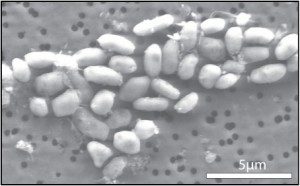Like poison for phosphorus
Scientists report finding bacterium that can live off arsenic
Share this:
- Share via email (Opens in new window) Email
- Click to share on Facebook (Opens in new window) Facebook
- Click to share on X (Opens in new window) X
- Click to share on Pinterest (Opens in new window) Pinterest
- Click to share on Reddit (Opens in new window) Reddit
- Share to Google Classroom (Opens in new window) Google Classroom
- Click to print (Opens in new window) Print

You may not know phosphorus when you see it, but your body does. Phosphorus is a sturdy workhorse element. In DNA molecules, phosphorus helps support the whole double helix. Within cells, energy shows up as ATP — and the “P” stands for phosphorus (specifically, phosphate, a form of phosphorus).
All life as we know it, in other words, depends on phosphorus. For that reason, scientists around the world were shocked December 2 when a team of scientists announced finding life forms that didn’t necessarily depend on this all-important element. In laboratory tests, the scientists grew bacteria that were able to use arsenic — a different element with similar chemistry — in the place of phosphorus.
It’s a surprising discovery because living organisms have never been found without all six of the ingredients crucial to life: carbon, hydrogen, nitrogen, oxygen, phosphorus, and sulfur (all together known as CHNOPS). Arsenic, though, is a potentially fatal poison.
Many scientists say they would like to see more evidence that the research team did in fact observe life forms using arsenic instead of phosphorus.
“This is an amazing result, a striking, very important and astonishing result — if true,” Alan Schwartz told Science News. Schwartz researches chemistry at Radboud University Nijmegen in the Netherlands. “I’m even more skeptical than usual, because of the implications. But it is fascinating work.”
The bacteria came from Mono Lake, a lake in eastern California that is well known for its unusual population of living organisms, including shrimp and algae. The lake doesn’t drain, so the only way for water to leave is through evaporation. As a result, the lake is much saltier than the ocean.

Several researchers had been studying a number of tiny organisms that lived in Mono Lake mud. Astrobiologists study life in the universe and want to know how it started, how it has changed, and what will happen to life in the future. They also want to know whether life exists on other planets and if so, what it might look like. Many astrobiologists study what lives in Earth’s strangest places, such as Mono Lake, as a way to understand the possibilities for life.
The study was led by Felisa Wolfe-Simon of NASA’s Astrobiology Institute and the U.S. Geological Survey in Menlo Park, Calif. She and her team removed organisms from the Mono samples and grew those bacteria in the lab. The scientists fed the microbes with sugar and vitamins — but left out phosphate. Then they changed the diet again, and gave the microbes arsenate, which is a form of arsenic.
In one type of bacteria, called GFAJ-1, the researchers observed that arsenic wasn’t fatal. The bacteria continued to grow, though not as fast as if they’d had phosphorus. After studying these bacteria, Wolfe-Simon and her team concluded that the organisms had begun to make use of the arsenic the way they usually used phosphorus. The researchers suggest that arsenic was being used as a building block in the bacteria’s DNA.
“This microbe, if we are correct, has solved the challenge of being alive in a different way,” Wolfe-Simon told Science News.
If the scientists are right, then “life as we know it” may not include all the life that actually is possible. For astrobiologists, that conclusion suggests that life on other planets may not necessarily look like life on Earth.
It’s possible that follow-up studies will show that the researchers were mistaken. Wolfe-Simon and her team could not get rid of all the phosphorus when they were growing the bacteria. Some scientists say minute amounts might be enough to keep the microbes alive. It’s possible that, in the experiment, the bacterium GFAJ-1 was still getting small amounts of phosphate.
Can life exist using poison instead of phosphorus? Life of a different type is an exciting prospect, so stay tuned to see how the scientific community reacts. Next up, scientists will want to know how, exactly, the arsenic substitution works.
POWER WORDS
arsenic A highly poisonous metallic element having three allotropic forms, yellow, black and gray, of which the brittle, crystalline gray is the most common. Used in insecticides.
phosphorus A highly reactive, nonmetallic element occurring naturally in phosphates.
DNA A nucleic acid that carries the genetic information in the cell. DNA consists of two long chains of nucleotides twisted into a double helix and joined by hydrogen bonds between the bases.
molecule A group of like or of different atoms held together by chemical forces.
microbe A minute life form; a microorganism, especially a bacterium that causes disease.
bacterium A life form that is a single cell and too small to see without using a microscope. Bacteria (plural of bacterium) live in almost every environment on Earth, including very cold places, very warm places, in all types of water, in the air, even on and in plants and animals. These microorganisms can also cause disease in plants and animals.







